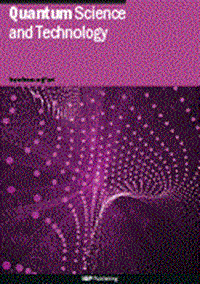使用随机单位对高q腔qudit的性能进行基准测试
IF 5
2区 物理与天体物理
Q1 PHYSICS, MULTIDISCIPLINARY
引用次数: 0
摘要
高相干腔谐振器是在高维希尔伯特空间中编码量子信息的优秀资源,超越了传统的基于量子比特的平台。一种自然的策略是使用Fock基对信息进行量化编码。人们可以通过将系统耦合到非线性辅助传输量子比特来对腔模量子比特进行量子运算。然而,腔式传输器件的性能受到噪声传输器件的限制。因此,以算法不可知的方式为这些quit系统开发实用的基准测试工具是很重要的。我们使用抽样测试来衡量这些qudit平台的性能,例如重输出生成测试以及线性交叉熵基准,通过模拟这样一个系统,使其受到现实的主导噪声通道的影响。我们使用选择性数相关的任意相位和无条件位移门作为我们的通用门集。我们的研究结果表明,当代的传输器可以轻松地控制几十个Fock能级的腔模式。这个框架允许对更高维度的量纲进行基准测试,因为这些量纲可以通过改进的传输来访问。本文章由计算机程序翻译,如有差异,请以英文原文为准。
Benchmarking the performance of a high-Q cavity qudit using random unitaries
High-coherence cavity resonators are excellent resources for encoding quantum information in higher-dimensional Hilbert spaces, moving beyond traditional qubit-based platforms. A natural strategy is to use the Fock basis to encode information in qudits. One can perform quantum operations on the cavity mode qudit by coupling the system to a non-linear ancillary transmon qubit. However, the performance of the cavity-transmon device is limited by the noisy transmons. It is, therefore, important to develop practical benchmarking tools for these qudit systems in an algorithm-agnostic manner. We gauge the performance of these qudit platforms using sampling tests such as the heavy output generation test as well as the linear cross-entropy benchmark, by way of simulations of such a system subject to realistic dominant noise channels. We use selective number-dependent arbitrary phase and unconditional displacement gates as our universal gateset. Our results show that contemporary transmons comfortably enable controlling a few tens of Fock levels of a cavity mode. This framework allows benchmarking even higher dimensional qudits as those become accessible with improved transmons.
求助全文
通过发布文献求助,成功后即可免费获取论文全文。
去求助
来源期刊

Quantum Science and Technology
Materials Science-Materials Science (miscellaneous)
CiteScore
11.20
自引率
3.00%
发文量
133
期刊介绍:
Driven by advances in technology and experimental capability, the last decade has seen the emergence of quantum technology: a new praxis for controlling the quantum world. It is now possible to engineer complex, multi-component systems that merge the once distinct fields of quantum optics and condensed matter physics.
Quantum Science and Technology is a new multidisciplinary, electronic-only journal, devoted to publishing research of the highest quality and impact covering theoretical and experimental advances in the fundamental science and application of all quantum-enabled technologies.
 求助内容:
求助内容: 应助结果提醒方式:
应助结果提醒方式:


